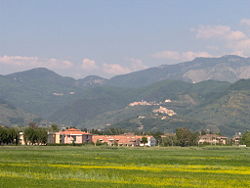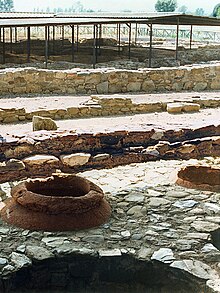Luni, Italy
Luni | |
|---|---|
| Comune di Luni | |
 View of Luni Mare with Ortonovo and Nicola in the background. | |
UTC+2 (CEST) | |
| Postal code | 19034 |
| Dialing code | 0187 |
| Patron saint | Madonna del Mirteto |
| Saint day | 8 September |
| Website | Official website |
Luni is a comune (municipality) in the province of La Spezia, in the easternmost end of the Liguria region of northern Italy. It was founded by the Romans as Luna. It gives its name to Lunigiana, a region spanning eastern Liguria and northern Tuscany (province of Massa-Carrara).
The commune was known as Ortonovo (from the name of one of its current frazioni) until April 2017. It is now named after the frazione of Luni.
Geography
Located in a plain near the
History
Classical Period
Luna was the frontier town of Etruria, on the left bank of the river Macra (now Magra), the boundary in imperial times between Etruria and Liguria.[a] When the Romans first appeared in these parts, Etruscans and the Ligurians were already in possession of the territory.[4](41.13.4)

The Roman city was established in 177 BC by Publius Aelius, Marcus Aemilius Lepidus, and Gnaeus Sicinius[4](41.13.4)[b] It was a military stronghold for the campaigns against the
Ancient harbour
Luni derived its importance mainly from its harbour,[6][3] which was on a gulf of the Tyrrhenian Sea now known as the Gulf of La Spezia, and not merely the estuary of the Magra as some authors supposed.[3][full citation needed][7][full citation needed] While the town was apparently not established until 177 BC,[4](41.13.4) when a colony of 2,000 Roman citizens was founded there, the harbour is mentioned by Ennius, who sailed from there to Sardinia in 215 BC under Manlius Torquatus. It was also being contested by the Romans as early as 195 BC, when they were fighting the Ligurians and Apuans in the area.[8] The site was used as a base for the quarrying of marble from the quarries of modern-day Carrara,[3] as the marble in that quarry is fine, and the harbour allowed the marble to be shipped to Rome easily.[3][9]
Late antiquity

In the 5th century, it was still notable, as it was chosen as the seat of a
Middle Ages
It was repeatedly sacked by sea pirates, Saracens in 849, and Vikings who settled there in 860.[10] Luna is supposed to have been mistakenly sacked by the Viking leader Björn Järnsida, who thought it was Rome. He tricked his way in by pretending to be a dying Christian convert. The 9th century Bishop Saint Ceccardo, believed to have been martyred by the Vikings, is celebrated on 16 June.[11][12]
In the mid-10th century it experienced the last period of splendour under count
It was only in 1442 that the highly visible remains were identified with Luni and the Gulf of La Spezia recognized as its harbour.[14] The depredation of the Roman ruins of Luni aroused the concern of the local Cardinal Filippo Calandrini, who urged the Humanist pope Pius II to issue a brief (7 April 1461) forbidding any further dilapidations. It was of little practical use: When the Palazzo del Commune of Sarzana was constructed in 1471 dressed stone from Luni supplied a considerable part of the building material.[13](p 112) In 1510 the city council of Sarzana made a gift to the French governor at Genoa of a marble triton found at Luni.[13](p 114)
Archaeological excavations

Luni was excavated in the 1970s and many of the material brought to light is now housed in the adjacent museum (44°03′50″N 10°01′01″E / 44.064°N 10.017°E). Archeological evidence suggests that the Roman forum had been abandoned as a public space by the end of the sixth century CE, its buildings fell to ruin or were demolished and decorative marbles removed. Remains of small wooden houses were found in the space previously occupied by the forum.[15]

A
.Main sights
- Remains of the elliptical Roman amphitheatre (1st century AD)
- Roman era artifacts are displayed the Luni Archaeological Museum[17]
- Sanctuary of Nostra Signora del Mirteto, at Ortonovo, consecrated in 1566
- Torre di Guinigi, a medieval tower in Ortonovo
- Castle of Volpiglione, located between Castelpoggio and Ortonovo, dating from the 11th-12th centuries.
- Castle of Nicola (13th-15th century)
- 19th century municipal building, at Casano
Footnotes
References
- ^ "Superficie di Comuni Province e Regioni italiane al 9 ottobre 2011". Italian National Institute of Statistics. Retrieved 16 March 2019.
- ^ "Popolazione Residente al 1° Gennaio 2018". Italian National Institute of Statistics. Retrieved 16 March 2019.
- ^ a b c d e Strabo 5.2.5
- ^ a b c d Livy. Ab Urbe Condita [Since the Founding of the City (of Rome)] (in Latin).
- ^ Kleiner, Diana E.E. The Ascent of Augustus and Access to Italian Marble (Multimedia presentation). Yale University.
- Pliny. Natural History. 3.8.
- 1911 Encyclopædia Britannica
- ^ Livy (A.U.C.)[4] 34.8.4-5, 34.56.1-2, 39.21.1-5, 39.32.1-3
- ISBN 978-3-8480-0321-1.
- ^ Celesia, E. (1847), [no title cited]
- ^ "San Ceccardo di Luni". Santi beats e testimoni. Retrieved 7 November 2018.
- ^ "Ceccardus of Luni". CatholicSaints. Retrieved 7 November 2018.
- ^ a b c Weiss, Roberto (1969). The Renaissance Discovery of Classical Antiquity. Oxford, UK: Blackwell. pp. 111–114.
- ^ Bracelli, Giacomo. Descriptio orae ligusticae. cited in Weiss (1969).[13](p 111)
- ^ Ward-Perkins, B. (1997). "Continuitists, catastrophists, and the towns of post-Roman Northern Italy". Papers of the British School at Rome. 65: 157–176.
- ^ Cuntz (1904). "[no title cited]". Jahreshefte des Osterreich Arch. Instituts. 46.
- ^ "Luni National Archaeological Museum". luni.beniculturali.it (official site) (in Italian).
Sources
- This article incorporates text from a publication now in the public domain: Chisholm, Hugh, ed. (1911). "Luna". Encyclopædia Britannica. Vol. 17 (11th ed.). Cambridge University Press. p. 123. That, in turn, cites Dennis, G. (1883). Cities and Cemeteries of Etruria. London, UK. ii. 63. (T. As.).
{{cite book}}: CS1 maint: location missing publisher (link)
External links
- "Comune di Luni". comune.luni.sp.it (official site) (in Italian).
- "Luni National Archaeological Museum". luni.beniculturali.it (official site) (in Italian).


